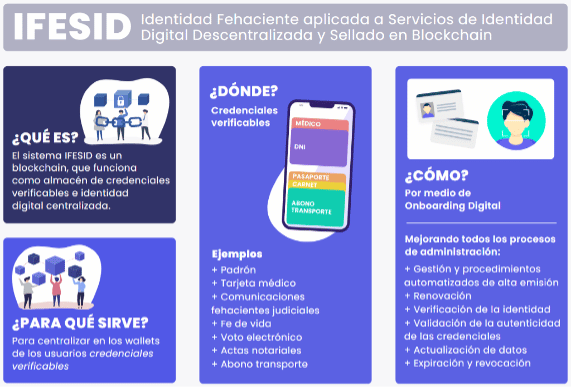Think of how many times in your life you have had to write in a form your name, surname, date of birth, ID card number, home address and a long etcetera. And now imagine that you only had to do it once. This is basically what makes digital identity sovereign, known as Self Sovereign Identity (SSI) and based on blockchain technology. It allows users to have control of their personal information. And if we add biometrics to this solution, we have the maximum guarantees of security and integrity.
Digitize the data request
Let's take an example to understand it better. Let's imagine a person who, in order to become a customer of a bank, must do an onboarding using a biometric system in which he/she must provide, for example, a selfie of his/her face. The system would issue a certificate of that biometric profile indicating that it belongs to that person, with a name, surname, ID card number, etc. This profile would be registered in a wallet, a digital purse, of the user, who could also add other certified data such as salary or income.
But let's continue with this assumption. The same person also wants to have an account in another bank. And to do so, at the other branch, in addition to the ID card, they request an additional validation and ask for their biometric profile to certify their identity unequivocally. On this second occasion, the photo would be contrasted with the profile registered at the first bank and stored in your wallet. This step would confirm that you are the person you claim to be. In this way, the second bank is trusting not in the customer, who at all times would be the owner of the data, but in the registration and validation made by the first entity.
This type of procedure, which seems simple and accessible, is the basis of the project in which Cuatroochenta is working together with Facephi, a Spanish company leader in biometric solutions and authentication, onboarding and digital identity technologies. The idea is to integrate biometrics to the sovereign or decentralized digital identity. This combination means that if one of the two banks wants to know, for example, whether the customer's annual income exceeds 30,000 euros, it would simply verify it without having to reveal the exact amount or the name of the company he works for.

«It is a much less intrusive identification system, since validating a person's identity does not require full disclosure. And it brings the value of verifiable credentials.».
Combining the advantages of biometrics and SSI, based on blockchain
The pandemic has generated an increase in demand for products and services related to digital onboarding and digital identity, at the same time that concerns about privacy and data protection have grown. Both companies have seen in this project an opportunity to offer a proposition that combines the advantages of trusted biometric identification with sovereign digital identity and blockchain technology. In fact, to date, no project has been presented worldwide with the features and advantages of integrating these technologies.

Fechaciente Identity applied to Decentralized Digital Identity Services and Blockchain Sealing.
The objective of this joint project, framed in the R&D cooperation program (PIDCOP-CV), is to be able to use biometrics as a means of identification in digital identity linked to credential management, improving usability and user experience. With this proposal, a horizon of possibilities for self-management of the processes of registration, issuance, renewal, maintenance, updating or cancellation of data and credentials linked to the identity of the user opens up. And all this, moreover, with guarantees of security and a value of authenticity only comparable to face-to-face attendance.
Soluciones Cuatroochenta S.A. has received a grant from the Instituto Valenciano de Competitividad Empresarial (IVACE) within the action PROYECTOS DE I+D EN COOPERACIÓN PIDCOP-CV, 2021. The objective of the project is the integration of reliable identity verification technology through biometrics in two types of services based on blockchain:
Possible use cases

«Both technologies, biometrics and SSI, become the perfect complement to materialize a user identification process with maximum regulatory compliance and meeting the cybersecurity requirements required to generate this network of trust, which provides reliability throughout the process and ensures data privacy».
This technology integration will improve Cuatroochenta's and Facephi's current services and products to make them more accessible to any technological niche. Thus, for example, we are working on the integration of Facephi's reliable biometric identification system in Cuatroochenta's intelligent platform for the management of CheckingPlan services and in Cuatroochenta's technological platform for the integral management of FAMA assets and infrastructures.
This technology can be incorporated into a wide range of sectors, from education to fintech, public administration, healthcare, travel, transportation and leisure. This extra layer of security provided by digital onboarding and identity verification solutions benefits users, companies and customers alike. Users will be able to control their personal data more securely and efficiently. And at the same time, companies will be able to receive the data required to provide the service requested by the customer.
In addition, the ease of use is designed to make it more accessible to any type of user and to extend its application to all social sectors. The development of this solution is adjusted at all times to the current regulatory framework of the European Union and could enrich the European project of digital identity European Self-Sovereign Identity Framework (ESSIF), called to lead worldwide the new concept of secure digital identity.
